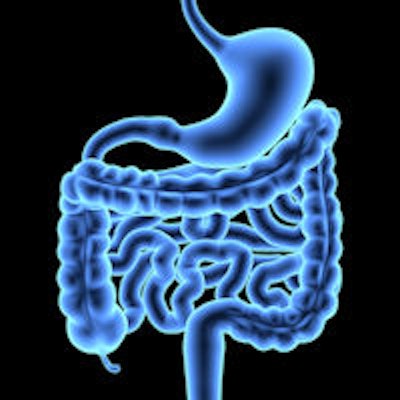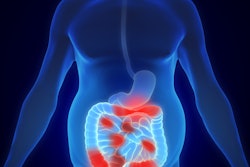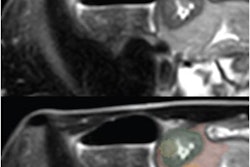
Quantitative analysis of contrast-enhanced ultrasound (CEUS) exams outperforms other ultrasound methods for characterizing the inflammatory activity of Crohn's disease, according to researchers from the Sixth Affiliated Hospital of Sun Yat-sen University in Guangzhou, China.
In a study that compared quantitative CEUS with qualitative CEUS analysis and power Doppler, the researchers found that quantitative CEUS yielded the highest sensitivity and accuracy for differentiating active from inactive Crohn's disease.
"Quantitative analysis of contrast-enhanced ultrasound can provide more objective information than [qualitative evaluation] of ultrasound contrast-enhancement patterns and power Doppler in assessment of the activity of Crohn's disease," said Dr. Guangian Liu. "It should be recommended in clinical practice."
She presented the findings during a scientific session at the recent American Institute of Ultrasound in Medicine (AIUM) annual meeting in New York City.
A chronic disease
Crohn's disease is a chronic and long-lasting inflammatory disease. It can involve any segment of the gastrointestinal tract, but it most frequently occurs at the terminal ileum, Liu said.
Inflammation caused by Crohn's disease can lead to transmural inflammation, i.e., infection of all layers of the intestinal wall. In clinical practice, Crohn's disease activity can be monitored with several methods, including endoscopy, clinical disease activity index (CDAI), laboratory tests, and imaging modalities such as MR enterography and CT enterography. However, each technique has limitations.
"Ultrasound provides a widely available, noninvasive, and economical method for evaluating the gut," she said.
In fact, the European Crohn's and Colitis Organization stated that transabdominal ultrasonography is a useful addition for assessing bowel inflammation, according to Liu.
Value of CEUS?
The researchers set out to compare the clinical value of CEUS and power Doppler imaging for assessing Crohn's disease inflammatory activity. They enrolled 77 consecutive patients (55 men and 22 women) with confirmed Crohn's disease at their hospital; the patients in the study had a mean age of 35 ± 15 years with a range of 18 to 69 years. The high-sensitivity C-reactive protein (hs-CRP) test was used as the reference standard for differentiating patients who had active disease from those with inactive disease.
All patients received contrast-enhanced ultrasound on a Logiq E9 scanner (GE Healthcare) with a 2-mL dose of Bracco's SonoVue ultrasound contrast agent (known as Lumason in the U.S.). Patients fasted for six to eight hours prior to the study and then drank a 2,000-mL water solution that contained 250 mL of mannitol. A 2.5-MHz convex-array probe was used initially, followed by a 7- to 9-MHz linear-array probe. Grayscale ultrasound was followed by power Doppler imaging and then CEUS.
On power Doppler imaging, intestinal wall vascularity was graded according to the Limberg classification scheme. With CEUS, radiologists qualitatively assessed the contrast enhancement patterns by determining if there was low or high enhancement in the bowel, if there was submucosal or transmural enhancement, and if the transmural enhancement was outward or inward. Quantitative CEUS analysis was performed by choosing a region of interest and calculating relative peak intensity (by subtracting minimum intensity from maximum intensity).
Bowel wall thickening is the most common ultrasound finding in Crohn's disease. However, transmural fibrosis or inflammation can lead to loss of normal gut layer stratification, Liu said.
On grayscale ultrasound, the mean thickness of the intestinal walls was 8.5 ± 2.2 mm in the active-disease group, compared with 7.0 ± 1.3 mm in the inactive-disease group. The difference was statistically significant (p = 0.037). However, there was no significant difference for stratification in layers between the two groups.
Relying on qualitative CEUS criteria for distinguishing between active and inactive disease provided similar sensitivity and accuracy to power Doppler imaging, she said.
Quantitative CEUS analysis
Quantitative CEUS offered the best performance. The group of patients with active Crohn's disease had a mean peak intensity level of 21.7 ± 3.7 dB, compared with 18.6 ± 3.0 dB in the inactive-disease group. The difference was statistically significant. As determined by receiver operator characteristics (ROC) analysis, the threshold of peak intensity level to differentiate active and inactive Crohn's disease was 20.35 dB.
| Performance for detecting active Crohn's disease | |||
| Method | Sensitivity | Specificity | Accuracy |
| Power Doppler | 68% | 57% | 64% |
| Qualitative CEUS | 67% | 71% | 69% |
| Quantitative CEUS | 84% | 64% | 78% |
"The sensitivity and accuracy were much higher than power Doppler and qualitative CEUS," she said.
A number of factors influence the accuracy of each method for differentiating active and inactive Crohn's disease. For example, Limberg classification on power Doppler is susceptible to the thickness of the abdominal wall, peristalsis of the intestine, and ultrasound techniques used. Qualitative CEUS may be subjective, as the four enhancement patterns were artificially determined, she said. In addition, the disease course can also influence the contrast enhancement pattern.
"Quantitative contrast ultrasound [is] more objective in comparison to the two [other] methods," Liu said.




















